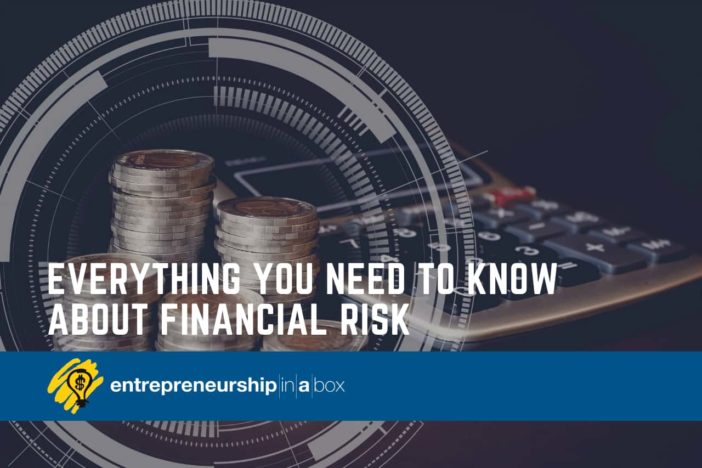You’ve probably heard statistics about the rate of business failure for new ventures. It might surprise you to know that the majority of new businesses survive their first year. By five years, though, almost half of new businesses have shuttered their doors. Is there a financial risk that will need to be taken into account?
There are many reasons for this situation, but some of the most common are cash flow issues and running out of cash.
It’s also easy to see why businesses may survive a year or two before disappearing from the scene. Most entrepreneurs know financial risks in the first few months of business.
You might think businesses are somehow immune to risk by reaching five years. New technologies or the disappearance of a major account can spell trouble.
As you can see, there’s no point in a business’s life where it stops being risky. The best thing entrepreneurs can do is learn to manage financial risk effectively.
Table of contents
- What is Financial Risk?
- How to Calculate Financial Risk?
- What Do Financial Risks Look Like?
- No Pain, No Gain
- Business Risk vs. Financial Risk
- Managing Risk the Right Way
- Risk Management Means Planning
- Managing Cash Flow as a Financial Risk
- Other Types of Risks
- Getting Help with Risk Management
- What Is a Risk Manager?
- Nothing Ventured, Nothing Gained
What is Financial Risk?
An important aspect of entrepreneurship is understanding your finances. Every business owner must be prepared for all eventualities, and financial risk is certainly one of those. Most business owners do not know where to begin when it comes to financial risk, but the key is to understand what it is.
What is financial risk, and why is it so difficult to recognize?
The answer is simple and complex at the same time.
Financial risk is when a business faces the possibility of losing money, and it’s not always due to bad luck. Instead, it is often due to poor planning or mismanagement.
In finance, financial risk is a term used to describe the risk that an investment will not produce the expected return. So, financial risk is simply the uncertainty of whether something bad will happen or not.
How to Calculate Financial Risk?
Financial risk, as a concept, is simple to understand. But, when you start calculating it, things get a bit tricky. It’s difficult to give any general rules since there is no one true formula that fits all situations. Some financial risk is based purely on probabilities—in other words, what is likely to happen. But financial risk can also include the impact of a loss on an individual, a company, or even a society. It can be something as simple as a missed opportunity or as complex as a social change.
To calculate financial risk, you need to know the potential outcomes of investment. The riskier the investment is, the more likely it is to lose money.
Risk is a combination of three things: likelihood, potential damage, and the potential cost of recovery if something bad happens. All three elements must be considered to get a complete picture of financial risk.
What Do Financial Risks Look Like?
Most entrepreneurs are familiar with the concept of financial risk.
Financial risks involve handling the cash flow in and out of business. Taking on a new loan is a risk because it increases your financial obligations. Hiring a new employee is a risk because you’ll need to pay this person regularly.
Financial risk could be almost any financial transaction in the business. This includes paying an employee to fund product development.
Some common financial risks include:
- Poor cash flow management
- Taking on too much debt
- Not invoicing clients on time
- Payroll and employee benefits
A late-paying customer can also be considered a financial risk for your business. A new client may also be risky, especially if you don’t do a thorough background check. You may deliver products or services you never receive payment for.
External factors also present risks. A downturn in the economic markets may mean your investors decide to pull out of a deal. This represents a risk for you since you could lose funding.
No Pain, No Gain
There’s another word for “risk” in business: opportunity. Investing in your marketing plan during a downturn can be considered a financial risk.
You can also see it as an opportunity to find more customers. If your strategy is successful, you could end up growing the business.
The same is true of taking on debt. A pizzeria owner may need a new pizza oven to grow the business. The debt is a risk because there’s a chance they may not be able to pay it back.
It may also represent an opportunity. They buy a second oven with the loan money to serve their customers even better experiences. They attract more customers as a result.
They might also decide to open a second location with the new oven. Now they can reach customers who didn’t buy before.
Business Risk vs. Financial Risk
Keep in mind that financial risk is almost always a business risk. Business risk is not necessarily financial, though.
A new competitor moving into your market risks your business, but it’s not a financial one. The same is true of a market downturn that leads to lower demand. Non-compliance with the law has financial impacts, but it’s not a financial risk.
By five years, almost half of the new businesses have shut down their doors. It’s easy to see why they may survive a year or two before disappearing. Most entrepreneurs know financial #risk in the first few months of #business.Click to PostManaging Risk the Right Way
As you can see from these examples, financial risk is a double-edged sword for most businesses. Spending money or bringing on new clients comes with a risk, but it’s also an opportunity.
The key is to manage financial risk more effectively for your business. It only makes sense to take on a loan for new equipment if it helps you grow the business or maintain operations.
Suppose our pizzeria owner’s oven breaks, but they can’t afford to replace it. Taking the loan is risky, but they must take it to keep their doors open. A pizzeria without an oven isn’t going to make much pizza, and it won’t be in business much longer.
Adding a second oven to their operation is also a risk, but it may be one that makes sense. After research, the owners discover people on the north side of town want more pizza choices. They don’t buy from this pizzeria because the location is too far away.
Creating a second location is risky, but the owners know there are demands and interests. It’s a calculated risk that can help grow the business.
The owners can take more steps to lower their risks. They may shop around for loans to see if they can find a lower interest rate. They may supply some cash from their savings to lower the loan amount, thus reducing debt and risk.
Risk Management Means Planning
One of the reasons businesses may not make it to five years is the failure to plan ahead. Risk management relies on good planning.
A five-year plan illustrates the point. The business owner may make plans for careful, stepped expansion over those five years.
Those expansion plans may hinge on growth. If growth doesn’t occur, then the business won’t take on new debts or hire more people. If growth is faster than expected, the business may need to hire more or decide to take on new debt sooner.
The plan should also make provisions for reviewing the business’s risk profile often. The plan should be flexible enough to accommodate new risks that emerge over time.
Managing Cash Flow as a Financial Risk
Another key to reducing financial risk for businesses is better cash flow management. More than 80 percent of businesses fail because of cash flow issues.
At its most basic, cash flow management is the art of balancing the money coming in with the money going out. There are simple steps to take to manage cash flow more effectively.
One is to reduce overhead so that more money comes into the business than leaving its coffers. This isn’t always possible. Cost-saving measures can still help improve cash flow.
Good policies around client billing can also help. If you invoice your clients, make sure they’re invoiced on time. Sending reminders before the bill is due and following up on overdue bills is good practice.
You should also vet your clients before you bring them on. Does this client have a history of late payments or non-payments? If so, you may want to ask for a down payment or another upfront fee.
These measures can help you get paid on time. In turn, having funds arrive on time will help with your cash flow. Outstanding invoices and non-paying clients are financial risks for your business.
Other Types of Risks
As mentioned, debts are financial risks. Any sort of financial transaction, such as spending more on marketing or paying new employees, is another risk.
Employee benefits can become financial risks for your business. Suppose an employee has a health savings account. One day, they decide to cash it all out.
You have to pay them out, but where is that cash coming from? If you haven’t managed your risks properly, they might result from a loan payment or your operating budget. Employee backpay can present a similar problem.
There are legal dimensions to financial risks as well. A change in the law may increase your financial risk by increasing how much you need to pay employees for overtime.
Managing cash is thus key to managing financial risk. Leveraging risk well will help you grow the business. Managing it poorly could lead to the closure of the business.
Getting Help with Risk Management
Planning for and managing risks is something of an art for most people. It can be difficult to see the future. What new threats may emerge?
Entrepreneurs may also be focused on the here and now. That’s why working with a financial risk manager can be helpful.
What Is a Risk Manager?
A financial risk manager is a trained professional. They’ve taken the FRM exam and have financial risk management certification.
They can use their expertise to help you plan for and manage risk more effectively. They’re well-versed in identifying and evaluating risks.
They can consult their FRM notes to help you develop a strategy to manage risk for your business. As we mentioned, risk never disappears for businesses. Managing it the smart way is thus crucial.
Good risk management can also help you grow your business. Your manager should make recommendations to leverage risk and grow your business.
Nothing Ventured, Nothing Gained
Financial risk is a natural part of any business. Learning how to manage it the right way will power your business to success.
Looking for more great financial tips for your next venture? Take a look at our informative articles for the best advice.





